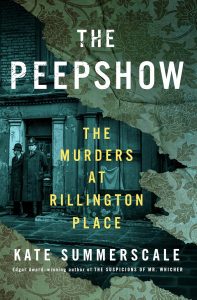Penguin
Review by Walter Cummins

The Peepshow, Kate Summerscale’s latest true crime book, goes beyond the gruesome details of serial butchery, with corpses stashed under floors, behind walls, and stuffed into sheds. That display of London low life titillated the millions who bought the newspapers that sensationalized the details for their circulation wars. But Summerscale, who could have outdone the British journalists of the 1950s, isn’t satisfied with sex and gore. Her goal is Dickensian, to reveal the parallels of decadence and shame that still ran through all levels of British society a century after Dickens. Unlike Dickens, she does not put her outrage into words [“Dead, your Majesty. Dead, my lords and gentlemen. Dead, right reverends and wrong reverends of every order. Dead, men and women, born with Heavenly compassion in your hearts. And dying thus around us every day”], but instead she lets the facts of the situation speak for themselves.
An irony at the heart of the book is all the investigative and journalistic energy devoted to revealing the details of the murders while a similar effort was exerted to suppressing revelations that would embarrass those in power. For all the bizarreness of the crimes and especially of Reg Christie, the murderer, much of the case was inseparable from matters concerning British society that officialdom wanted to bury.
Summerscale begins the book with the grizzly discovery of the bodies and then shifts her focus to journalist Harry Proctor, the Sunday Pictorial’s star exposé reporter, who had met Reg Christie before he was a suspect. Over the course of the investigation and trial, Procter was a major contributor to all the columns of print devoted to Christie. He was willing to break laws to get access to Christie and even fabricated Christie statements. It’s what the audience craved. Eighty percent of Britian’s fifty million population read a daily paper. But Procter’s conscience accumulated guilt, leading him to quit sensational journalism and eventually write a book that condemned the tactics of papers like his.
Perhaps even more than the vicious nature of the crimes, the twisted character of Christie fascinated readers. He was estimated to have an above average intelligence and used his wits to manipulate the investigation and the trial itself as his lawyers tried to prove he should escape hanging because of insanity. That didn’t work. But, if not technically insane, he was far from normal, which many related to his sexual inadequacy that included necrophilia with his dying victims.
Christie took advantage of London’s poverty and the resulting prostitution that created an environment enabling his actions. Summerscale depicts the lives of those who had no options to living in a crowded slum like 10 Rillington Place, with its filth and foul odors: “Paint peeled from its sandstone portals, stains spread across its crumbling facade.” A housing shortage had resulted from the consequences of World War II through bomb damage and a building moratorium that led to landlords charging exorbitant rates. One result of the housing crisis was its contribution to the breakdown of society, with a doubled crime rate. The number of divorces exploded from fewer than 5,000 dissolutions in 1937 to 60,000 in 1947. An estimated ten thousand prostitutes were working in the city, the murder victims among them.
Despite the danger of involvement in the trade, many women chose it because the earnings was far more than, for example, factory work. A young woman, Rosalind Wilkinson, was hired to do a study of prostitution that involved extensive interviews and just informal conversations with the women. She concluded that the women had made a compelling rational choice in light of the employment alternatives that paid much less. When the report was published in 1955, the author was left anonymous. The council that had hired her disowned her conclusions that legal or social reforms would make little difference in discouraging the women and that a more useful study would be of the men who hired prostitutes.
Once Christie was executed, one question of guilt remained unsettled, a focus on what was called the Evans case, with Christie and Tim Evans, previously hung, quoted again and again over the question of which actually killed Evans’s wife, Beryl, and his baby daughter, Geraldine. Both men admitted and denied it, Christie at one time accepting the death of Beryl but not the child but also confessing to killing her at another point.
Although the mystery of this uncertainty had its appeal to newspaper readers, something much more significant was at stake—power—which party would rule Britain. The issue was the death penalty, which the Tories wanted to keep and Labour wanted to suspend. If an innocent man, Evans, had been hung, the penalty lost much of its justification. To complicate matters, Prime Minister Churchill and his likely successor, Sir Anthony Eden, were gravely ill. A Pictorial columnist, quoted Churchill as saying, “At least I have had the honour of removing that creature Christie from the front pages.”
Not only was the Christie case vital to politics, royalty had a coincidental connection. In the midst of Christie’s trial, the coronation of Queen Elizabeth II took place not far away at Westminster Abbey in London. Society photographer Cecil Beaton went from taking what became famous pictures of the new queen one day to return to the courtroom the next. Beaton, very pleased by his portraits of Elizabeth, is said to have been repulsed by Christie, “his mouth thin and cruel.”
Dickens would have thrived with such a situation. Summerscale creates her own disturbing peepshow.
